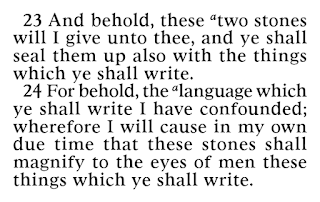“Deliberately misleading”? Really?
Jonathan Neville writes:
The passage in Saints is an interpretive reading, but it’s certainly not one without warrant. (And it’s far from being “deliberately misleading,” for heaven’s sake!)
Earlier in Joseph Smith’s history, he related what Moroni had told him the night before:
This is not hard to understand. —Peter Pan
The book Saints, volume 1, deliberately misleads readers by teaching them revisionist history. Here’s another blatant example.Footnote 19 in that chapter cites Joseph Smith—History 1:52, in which Joseph wrote that he beheld “the plates, the Urim and Thummim, and the breastplate.”
The book falsely describes the Urim and Thummim as “seer stones,” a term Joseph never applied to them. Beneath the boulder was a box, its walls and base made of stone. Looking inside, Joseph saw the gold plates, seer stones, and breastplate.19
(Vol 1: 1815–1846, Part 1, Chap 3: Plates of Gold, ¶28 • 1:25–26)
The passage in Saints is an interpretive reading, but it’s certainly not one without warrant. (And it’s far from being “deliberately misleading,” for heaven’s sake!)
Earlier in Joseph Smith’s history, he related what Moroni had told him the night before:
[Moroni, the angel,] said there was a book deposited, written upon gold plates, giving an account of the former inhabitants of this continent, and the source from whence they sprang. He also said that the fulness of the everlasting Gospel was contained in it, as delivered by the Savior to the ancient inhabitants; also, that there were two stones in silver bows—and these stones, fastened to a breastplate, constituted what is called the Urim and Thummim—deposited with the plates; and the possession and use of these stones were what constituted “seers” in ancient or former times; and that God had prepared them for the purpose of translating the book.Obviously, stones used by a seer are seer stones.
—Joseph Smith—History 1:34–35
This is not hard to understand. —Peter Pan







I've heard a lot about his feelings for Saints, Volume 1, but I wonder how he feels about the statement in Saints, Volume 2 which says that "[t]he Saints in the room already knew how an angel of the Lord had led him [Joseph Smith] to a set of gold plates buried in a hill called Cumorah" (p.4). Is he glad that the hill is referenced as being called Cumorah, or is he upset that it merely says that the hill was "called" Cumorah, rather than saying "the hill Cumorah"?
ReplyDelete